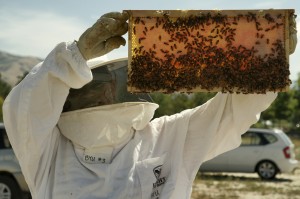
A weekend honey exchange was a family beekeeping business’ shot at redemption after red honey started showing up in area beehives.
The red honey was the result of bees being fed a mixture of crushed candy canes and water. The mixture, fed to the bees in open feeding pits, caused bees within the vicinity of the source to produce red honey in hives throughout Utah, Salt Lake, Davis and Washington counties, according to the Utah Department of Agriculture and Food.
After initially avoiding public identification, Boydean Frazier said his family business, Beehive Condominiums, was most likely the biggest contributor to the source of red honey.
Larry Lewis, public information officer for the state agriculture department, said the beekeeper made the red-colored mixture as feed for his bees to prepare them for winter. However, neighboring bees began feeding on the mixture and carrying it back to their hives.
Frazier, whose business maintains and rents beehives, said one of his sons set up an exchange, offering to swap marketable honey for red honey. The exchange was advertised to the beekeeping community on the Utah County Beekeepers’ Facebook page and on the Wasatch Beekeepers Association website.
“There was no coercion, no asking. It was something suggested and was accepted,” Frazier said concerning the swap.
The Saturday exchange took place at two locations, in Salt Lake City and Orem. According to Neil Shelley, a Utah County bee inspector, three people intended to make the swap in Orem but only two showed up. In total, the two beekeepers exchanged close to 100 pounds of red honey.
Chris Spencer, owner of 3 Bee Honey, said he was affected by the red honey but did not bother going to the exchange. Several beekeepers, including Spencer, said one reason they chose not to participate was because they were unsure where the honey they would be exchanging for was from.
Whether the exchange will calm the buzz in the beekeeping community remains to be seen. The red honey’s costs to beekeepers are still in question.
Associate microbiology professor Sandra Burnett leads a BYU research project that studies American Foulbrood Disease, an infectious disease that causes problems in honeybees. When red honey ended up in BYU hives this summer, she and others on campus began researching red honey with the state. “The person who caused this is trying to make restitution,” she said, estimating commercial costs in the “thousands of dollars.”
Bryan Merrill is a BYU molecular biology research student who has worked with BYU’s bees during the past two summers. “None of us have ever seen it before. We have heard there (have) been a couple of instances. Some bees in New York got into a maraschino cherry factory, and the honey turned red. Or in France, they got into an M&M waste-processing factory and the honey turned blue and green and orange,” he said.
Most of the Utah red honey has been thrown out or set aside for further review, according to other sources. According to a state press release, “Beekeepers who encounter this red ‘honey’ in their hives are not to mix it with other honey and are to report it to State Apiarist Dave Basinger.”
“It turns out the honey doesn’t taste good,” said Jenn Christensen, a BYU student who worked with Merrill this summer. “We can’t sell the honey. That means we get to harvest less honey, so it will be damaging for beekeepers, especially if they’re trying to make a profit and keep their beekeeping afloat.”
Some Utah beekeepers argue that feeding bees sugar-based products is natural and acceptable, even in an open feeding situation. Others beekeepers are more critical, saying that sugar-based feeding should only be done inside the hive.
Regardless of their stake in the controversy, many beekeepers are left frustrated with the red honey and wondering about short- or long-term effects.
“It has affected me in a way that it questions my beekeeping practices,” said Lee Knight, a commercial beekeeper who did not find red honey in his hives. “I’ve had to reeducate my customers what real honey is instead of this red sugar water.”
So far, BYU is looking at three potential issues, according to Merrill. The first is that of red 40 dye, which honey does not naturally contain, and the amount of lead it contains. Second, corn syrups or sugars heated above a certain temperature will convert into hydroxymethylfurfural (HMF), which has been known to be toxic to honeybees. The third issue is whether beekeepers can package and sell the product as “honey.”
“The state of Utah has run some lead testing and confirmed, at least on the samples, that the lead is not a problem,” Merrill said.
Burnett said the price of raw honey from some beekeepers in Utah has already gone up.
Burnett said she does not know whether the colored, sugary feed will affect the bees. “That’s what I am looking at.”




